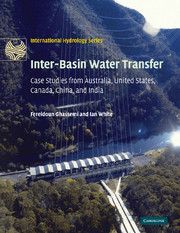Overview and Scope
Published online by Cambridge University Press: 05 November 2009
Summary
Large water infrastructure projects were completed throughout the world during the twentieth century to meet the increasing demands of burgeoning populations for irrigation and domestic water supplies. These projects saw the construction of dams, reservoirs, pipelines, pumping stations, hydro-power plants and irrigation systems within river basins. In several countries, major and in some cases almost heroic, projects were undertaken to transfer water from basins considered to have surplus water to basins where water demand exceeded or was expected to exceed the available supply. This book compares the contexts and experiences in inter-basin water transfer in countries with widely different water needs, population pressures, economies and forms of government.
Most large water infrastructure and inter-basin water transfer projects in the past were the domain of engineers and government bureaucrats. Many were undertaken with minimal assessment of environmental or social impacts and with rudimentary and in some cases doubtful cost–benefit analyses. Community participation in such schemes was either nonexistent or token. While many have benefited from such schemes, there has often been marked inequity in the distribution of benefits. There have been significant social, economic and environmental impacts, with poor and indigenous communities frequently bearing a disproportionate share of the impacts. Globally, millions of people have been displaced by large water projects. The predicted performance of water projects and projected cost recovery and profitability has often proved illusory.
- Type
- Chapter
- Information
- Inter-Basin Water TransferCase Studies from Australia, United States, Canada, China and India, pp. xix - xxiiPublisher: Cambridge University PressPrint publication year: 2007

